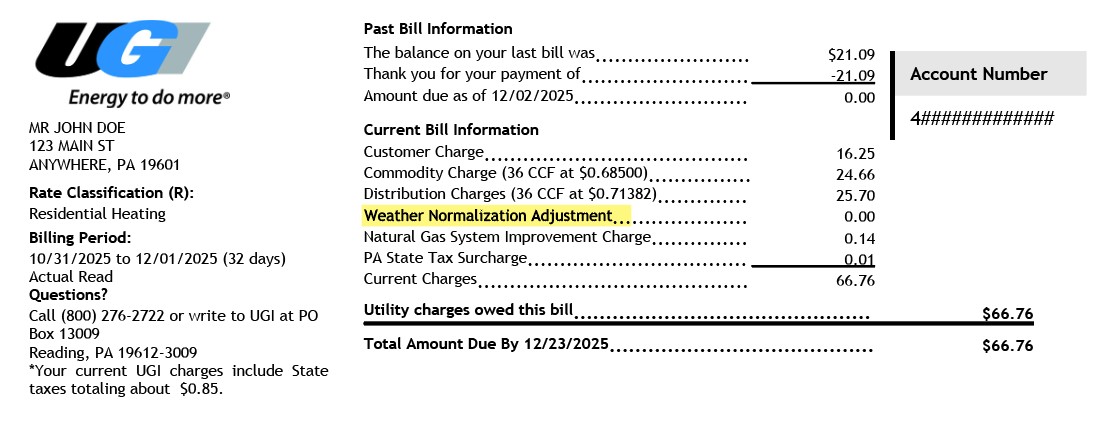Weather Normalization Adjustment (WNA)
- Weather Normalization Adjustment (WNA)
The UGI Utilities Weather Normalization Adjustment (WNA) was approved by the Pennsylvania Public Utility Commission (PUC), as part of a five-year pilot beginning in November 2022, for bills issued to UGI Gas customers during the heating season. This rate adjustment was approved to level out our regulated distribution charges when weather is different from the 15-year average weather used to calculate rates.
Understanding Natural Gas Bills
A bill has two main parts:
Commodity Charge
- The Commodity Charge is the amount charged for the supply of natural gas UGI buys on behalf of its customers.
- UGI does not profit on this portion of the bill.
- The charges are not affected by WNA.
Distribution Charge
- The Distribution Charge is the amount charged to transport that gas through pipes and equipment, maintain the system, and pay for customer service and universal service programs.
- These charges are affected by WNA.
Why Does the WNA Exist?
Distribution for utilities are established assuming customers will use natural gas based on normal weather. A 15-year average is used to calculate normal weather, but actual weather changes each bill period. When it’s colder or warmer than normal:
- Customers use more or less than expected.
- The cost to maintain utility pipes and equipment stays the same.
UGI Utilities requested the WNA because it seeks to have steady revenue. This allows it to more easily budget and ensure that it can maintain safe and dependable natural gas service. The PA Public Utility Commission reviewed and approved the use of the WNA.
How Does WNA Affect Customer Bills?
- The WNA charge or credit will appear on bills only in the months of October – April.
- WNA will not appear on bills when the weather is within 3% of the 15-year average.
- WNA charges will appear on when the weather is more than 3% warmer than the 15-year average.
- WNA credits will appear on bills when the weather is more than 3% colder than the 15-year average.

How is WNA Calculated?
Step 1: Compare Normal Weather to Actual Weather
The actual weather for the billing period is compared to normal weather using a concept known as Heating Degree Days (HDD). Heating Degree Days measure how much lower the average daily temperatures were than 65°F, the point below which heat is needed for most. To arrive at the WNA, Heating Degree Days are calculated both for normal weather (a 15-year average) and for the actual weather for the bill period.
- When Actual Heating Degree Days are more than Normal Heating Degree Days, the weather was colder than normal.
- When Actual Heating Degree Days are less than Normal Heating Degree Days, the weather was warmer than normal.
Step 2: Determine Adjusted Normal Heating Degree Days
WNA is only applied when temperatures are more than 3% colder or warmer than normal based on the Actual Heating Degree Days. To account for this 3% range, Normal Heating Degree Days are adjusted.
Normal Heating Degree Days +/- 3% = Adjusted Normal Heating Degree Days
Step 3: Calculate Weather Adjusted Usage
Weather Adjusted Usage is the amount of natural gas that would have been used if weather had been normal. Actual Usage on your bill is split into non-heating and heating usage estimates. Your estimated heating use is modified based on the Adjusted Normal Heating Degree Days (calculated in Step 2, above) and Actual Heating Degree Days for the bill period.
Est. Non-Heating Use + (Est. Heating Use × (Adjusted Normal HDD/Actual HDD))
= Weather Adjusted Usage
Step 4: Determine the Weather Normalization Adjustment
The WNA is calculated by multiplying the difference between Weather Adjusted Usage and Actual Usage by the Distribution Rate.
(Weather Adjusted Usage – Actual Usage) × Distribution Rate
= Weather Normalization Adjustment
For more details on WNA, please call UGI at 800-276-2722 or see Rider C – Weather Normalization Adjustment within Tariff for UGI Utilities, Inc. – Gas Division – PA P.U.C. NOS. 7 & 7S.
You may examine the PUC’s Order, which explains the PUC’s approval of UGI’s WNA at Docket No. R-2021-3030218 on the Pennsylvania Utility Commission Website.
Glossary
| AHDD | Actual Heating Degree Days |
| CCF | 100 cubic feet of gas |
| HDD | Heating Degree Days |
| NHDD | Normal Heating Degree Days |
| PUC | Pennsylvania Public Utility Commission |
| WNA | Weather Normalization Adjustment |